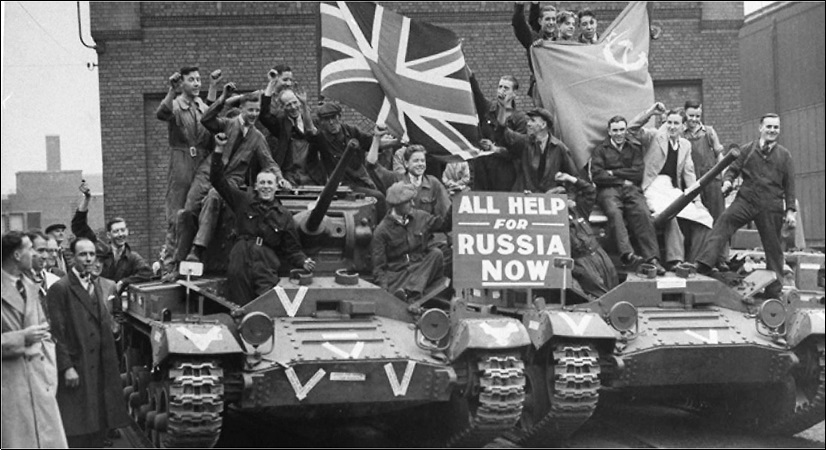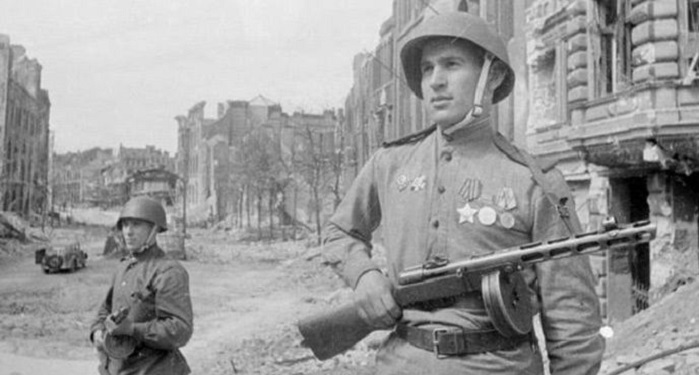● ● ●
Having
survived the opening round of the war and administered a
hard check to the German invader in the 1941-42 winter
offensive, the Red Army embarked upon the rebuilding of its
mobile forces. The old mechanized corps had mostly been
shattered in the opening battles and the formations that
replaced them were of a new, smaller but more efficiently
organized type. First came the 1941-42 tank brigade, which
became the basic unit of the division-sized
1942 tank corps.
This was a powerful unit for its size but it had some
disadvantages. With no field artillery and only six
infantry battalions—three of which were really
half-battalions—the tank corps lacked defensive staying
power. It could deliver a punch and gain ground but when
stopped it became extremely vulnerable to counterattack.
Many tank corps were mauled or destroyed in this manner.
Realizing the need for a large mobile unit that could move
rapidly, seize objectives deep in the enemy’s rear area and
defend itself against counterattacks, Stavka formed the
first mechanized corps in September 1942. Essentially they
were large armored divisions with plenty of infantry. The
mechanized corps was designed to serve as an exploitation
force alongside the tank corps, advancing through the gaps
created by the rifle divisions and the
artillery. Though
like the tank corps it had no true field artillery, the
mechanized corps did have ten rifle battalions, nine of them
in the corps’ basic unit, the mechanized brigade. This was a
motorized rifle brigade identical to that in the tank corps,
but with the addition of a tank regiment—actually a
battalion-sized unit with 41 x T-34 medium tanks. However,
the first mechanized corps to be raised received whatever
armor was available, including Lend-Lease British tanks such
as the Matilda and the Valentine.

British factory workers
with brand-new Valentine infantry tanks destined for the
USSR (Imperial War Museum)
The
mechanized corps was formed with three mechanized brigades,
a tank brigade identical to that found in the tank corps, a
heavy tank regiment, two
self-propelled artillery (armored
assault gun)
regiments, a 120mm mortar regiment, a rocket artillery
battalion and various support units. This table of
organization required a large and varied number of motor
vehicles, and made great demands on scarce technical
resources. Thus the Red Army was never able to raise more
than thirteen of them, some from scratch and some by
converting tank corps.
For the
same reasons, when the mechanized corps were first set up
some lacked various sub-units. For example, the 1st Guards
Mechanized Corps, assigned to Southwestern Front for the
Battle of Kursk in 1943, had no tank brigade and only one
self-propelled artillery regiment. On the other hand the
3rd Mechanized Corps, assigned to the 1st Tank Army at Kursk,
had two tank brigades, possibly in compensation for its lack
of self-propelled artillery battalions. Only in 1944 were
the mechanized corps largely standardized. It was common,
however, for extra units—typically tank and self-propelled
artillery regiments and rocket artillery battalions—to be
attached to the corps when deemed necessary. Also common
were detachments of corps assets—usually tank and
self-propelled assault gun regiments—to other formations.
It
should be noted that Red Army unit designations sometimes
gave a false impression of size. Medium and heavy tank
regiments were actually battalion-sized units with 41 tanks
for the former and 21 for the latter. The tank brigade found
in the mechanized and tank corps was also the size of a
battalion, with 41 to 63 tanks. Self-propelled
artillery regiments were also battalion sized, with 21
armored vehicles. And as has been noted, the mechanized
corps and the tank corps were actually the size of German or
Western Allied armored divisions.
As for
equipment, by 1943 in most mechanized corps the tanks and
self-propelled assault guns, antitank guns and artillery
were of Soviet manufacture. The T-34 medium tank, indeed,
was one of the war’s outstanding weapons—especially the
T-34-85 with its powerful 85mm gun, which entered service in
1944. But many other vehicles, particularly trucks, were
acquired via Lend-Lease. The US and the UK provided about
410,000 trucks to the USSR, as against the 300,000 or so
manufactured domestically. The entire production of 2.5-ton
cargo trucks by Studebaker’s South Bend, Indiana
manufacturing plant went to the USSR. The Red Army received
in addition thousands of US armored halftracks, US armored scout cars
and British Universal Carriers. Large numbers of such
vehicles found their way into the mechanized corps, as shown
in the accompanying diagrams.

Red Army soldiers armed
with the PPSh-41 submachine gun. It was widely issued to
troops of motorized, mechanized and armored units (World War
Photos)
At the
operational level, the mechanized corps was usually assigned
to a tank army, the standard organization in 1944-45 being
two tank corps and one mechanized corps. Sometimes a
mechanized corps was assigned in place of a tank corps to an
infantry or shock army participating in a major offensive;
others were held in reserve at the front level.
A mechanized corps (or units
thereof) was sometimes paired with one or two cavalry corps
in a cavalry-mechanized group (CMG). This was an
exploitation force for employment in attacks over rough
terrain. In addition to its major elements, the CMG included
an array of support units: self-propelled artillery
regiments, artillery brigades and rocket artillery
regiments, antitank and antiaircraft units, etc. The CMG was
not a permanent, numbered formation, being formed with units
held in front reserve, and it took the
name of its commander, e.g. Cavalry-Mechanized Group Gorshkov.
Making
due allowance for the limitations imposed by Soviet
conditions, the mechanized corps was a large, well-armed
mobile formation that when properly handled was more than
capable of standing up to the German panzer division. What
gave the German division its edge was better staff work and
training plus real division artillery. Though these advantages
diminished over time, the German Army was generally more
efficient to the Red Army right up to the end of the war.
The latter only acquired a decisive advantage from late 1943
on, when its numerical superiority in manpower and every
category of weapon became overwhelming.
● ● ●